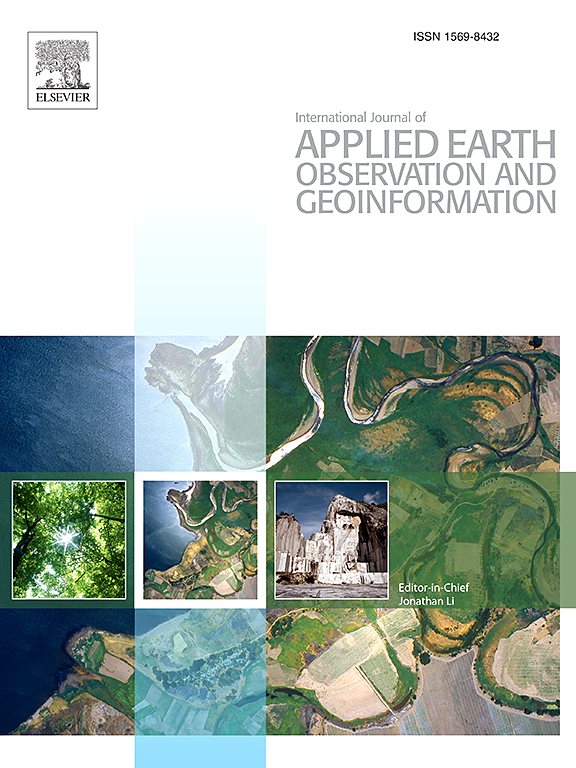Satellite images reveal rapid development of global water-based photovoltaic over the past 20 years
IF 7.5
1区 地球科学
Q1 Earth and Planetary Sciences
International Journal of Applied Earth Observation and Geoinformation
Pub Date : 2025-01-10
DOI:10.1016/j.jag.2025.104354
引用次数: 0
Abstract
Water-based photovoltaics (WPV) have emerged as a promising solution to land-use conflicts associated with solar photovoltaic systems. Accurate monitoring of the spatiotemporal distribution of WPV is essential for evaluating its development potential, environmental impacts, and informing policy decisions. Satellite remote sensing data offer a feasible approach for WPV mapping and monitoring. However, conventional image classification and deep learning methods often limited by sample size requirements, computational costs, and technical complexity, which hinder their widespread applicability. To address these challenges, this study proposes a novel index, the normalized difference photovoltaic index (NDPI), for WPV detection. We generated a global WPV map for the year 2023 using Sentinel-2 MSI imagery and NDPI. Additionally, by integrating NDPI with Landsat time series data, we determined the installation dates of WPV systems and evaluated their development trends from 2000 to 2023. Our results show that: (i) The NDPI demonstrated excellent performance in WPV detection, with overall accuracy for spatial location and installation dates of WPV was 0.935 and 0.927, respectively, and Kappa coefficients of 0.870 and 0.921. (ii) Global WPV coverage in 2023 reached 589.17 km卫星图像显示,近20年来全球水基光伏发电发展迅速
水基光伏(WPV)已成为解决与太阳能光伏系统相关的土地使用冲突的有希望的解决方案。准确监测野生生物多样性的时空分布对于评估其发展潜力、环境影响和为决策提供信息至关重要。卫星遥感数据为WPV制图和监测提供了一种可行的方法。然而,传统的图像分类和深度学习方法往往受到样本量要求、计算成本和技术复杂性的限制,这阻碍了它们的广泛应用。为了解决这些挑战,本研究提出了一种新的指数,即归一化光伏指数(NDPI),用于WPV检测。我们使用Sentinel-2 MSI图像和NDPI生成了2023年的全球WPV地图。此外,通过整合NDPI和Landsat时间序列数据,我们确定了WPV系统的安装日期,并评估了其2000年至2023年的发展趋势。结果表明:(1)NDPI在水样pv检测中表现优异,对水样pv空间位置和安装日期的总体精度分别为0.935和0.927,Kappa系数分别为0.870和0.921。(ii) 2023年全球WPV覆盖面积达到589.17 km2,其中亚洲是主要贡献者,占比超过97%。中国以472.92平方公里的WPV面积,明显超过其他国家,跃居首位。50平方公里)。(iii)从2000年到2023年,特别是在2015年之后,WPV经历了显著增长。2015 - 2023年WPV面积增加了434.57 km2,几乎是前15年总面积的3倍。所提出的npi为全球WPV时空监测和基本信息更新提供了一种通用的方法。它还为评估WPV在整个运行周期中的环境影响提供了潜力。
本文章由计算机程序翻译,如有差异,请以英文原文为准。
求助全文
约1分钟内获得全文
求助全文
来源期刊
CiteScore
10.20
自引率
8.00%
发文量
49
审稿时长
7.2 months
期刊介绍:
The International Journal of Applied Earth Observation and Geoinformation publishes original papers that utilize earth observation data for natural resource and environmental inventory and management. These data primarily originate from remote sensing platforms, including satellites and aircraft, supplemented by surface and subsurface measurements. Addressing natural resources such as forests, agricultural land, soils, and water, as well as environmental concerns like biodiversity, land degradation, and hazards, the journal explores conceptual and data-driven approaches. It covers geoinformation themes like capturing, databasing, visualization, interpretation, data quality, and spatial uncertainty.

 求助内容:
求助内容: 应助结果提醒方式:
应助结果提醒方式:


